With the approaching cold weather thinking about buying a device for heating a room with minimal fuel consumption? You have heard that a catalytic gas heater is compact and quite efficient, but unlike most gas appliances, it is completely safe. Is it really so? Agree, buying an expensive "pig in a poke" is not included in your plans.
We will help you deal with this type of heaters - in our publication we will talk about the design features and principles of operation of catalytic devices. Let's consider how they provide high thermal efficiency and give recommendations for choosing the right model. We will also pay attention to the best manufacturers who have received the most positive feedback from customers.
The content of the article:
- The device and principle of operation of such heaters
- The main types of designs
- Differences from gasoline and multi-fuel models
- Pros and cons of catalytic appliances
-
Choosing the optimal heater
- Criterion # 1 - place and conditions of application
- Criterion # 2 - technical characteristics
-
Review of the best manufacturers
- No. 1 - reliable and functional Bartolini devices
- # 2 - compact and economical models from Campingaz
- No. 3 - comfortable and safe heaters from the Kovea brand
- No. 4 - inexpensive and durable heaters from Argo
- Conclusions and useful video on the topic
The device and principle of operation of such heaters
Catalytic type heaters are able to warm up the apartment until the centralized heating is turned on, heat a small country house for the weekend, will help you stay warm in the garage and solve a number of other heating issues premises. Most of the models are very compact: they can be easily taken to the country or on a hike, always staying warm even outside the house.
But the purchase of such a heater should be approached with special care, having previously understood the design features and principles of operation of the devices.
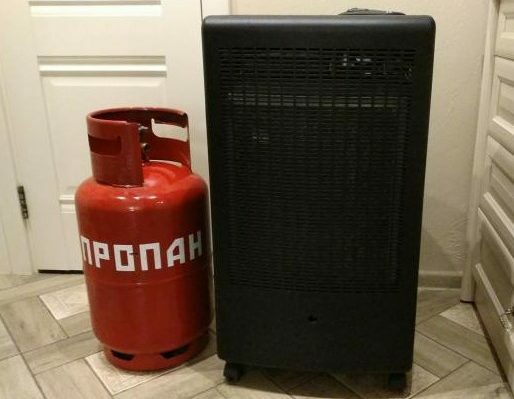
Catalytic heaters can operate not only on a liquefied cylinder, but also on gas supplied through the centralized gas supply system. It depends on the technical capabilities of a particular model.
The catalytic heater generates heat as a result fuel mixture oxidationentering the catalyst - the catalytic plate.
Due to the absence of a direct flame during its operation, combustion products harmful to health are not formed. At the same time, fuel consumption is minimal.

Heat in catalytic devices is generated by a chemical reaction triggered on the surface of the catalyst. Gas is fed to the plate through many small holes, after which the oxidation process begins
Standard designs consist of:
- control panels;
- catalyst;
- steel body;
- mixing chamber;
- diffuser.
Some models are equipped with special tubular electric heaters that serve as an additional heat source.
The main working part on which the work of such heating devices is based is catalyst plate. It is made of fiberglass mesh with a sprayed layer of palladium or platinum.
As additional structural elements, there may be a built-in ignition device, a thermostat, an automatic shutdown.
The principle of operation of a catalytic heater is fundamentally different from those by which other gas appliances work. In standard circuits, heat energy is released after the ignition of the fuel entering the burner.
The room heating system with a catalytic device looks different:
- When switched on, the catalyst surface gradually heats up and reaches a temperature of 200-500 ° C, depending on the selected mode.
- At the same time, the air-fuel liquid is heated in the mixing chamber.
- Liquefied gas vapors are fed to the hot catalytic panel.
- Under the influence of a catalyst, a chemical reaction is triggered, providing a flameless combustion.
Despite their compact size, the devices produce a rather impressive amount of heat, which is enough to heat a large area.
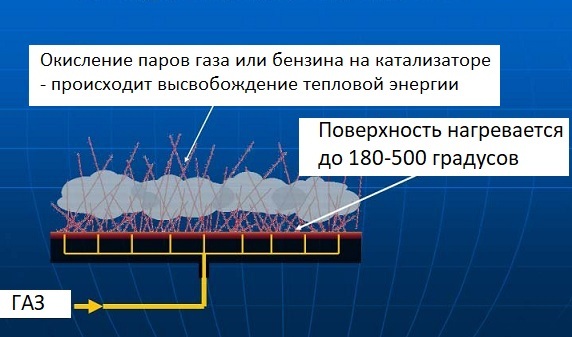
During catalytic combustion, the fuel mixture completely burns out: carbon monoxide is not emitted into the room, and the oxygen level remains at the same level
Most often, devices are used to heat small construction projects, garages, country houses, outbuildings, tents, greenhouses, temporary huts. It is not recommended to use them for permanent heating of residential premises, except for the period of construction or repairs, when the main heating system is not yet connected.
The main types of designs
By connection type there are designs that are connected to a cylinder with a propane-butane mixture or to a centralized gas pipeline. What is it used for gas hose.
Catalytic heater models differ in type of construction. The most common option is a monolithic version, in which a container intended for liquefied gas is placed inside the body. The volume of such a cylinder is no more than 27 cubic meters.
In the second possible modification, there is no housing: only a plate impregnated with catalysts. Such heaters are very compact, they can be taken with you on camping trips and travels to heat vehicles or tents.
Some units are completed with special CO2 sensorscontrolling the level of gas in the room. In the event of an increase in values to critical levels, an automatic system is triggered, instantly turning off the fuel supply.
The device can be conventional or infrared. V infrared gas catalytic heaters a ceramic panel is used. They are also equipped with a reflector located on the inner surface. It provides a targeted local effect and allows you to quickly reach a comfortable thermal range.
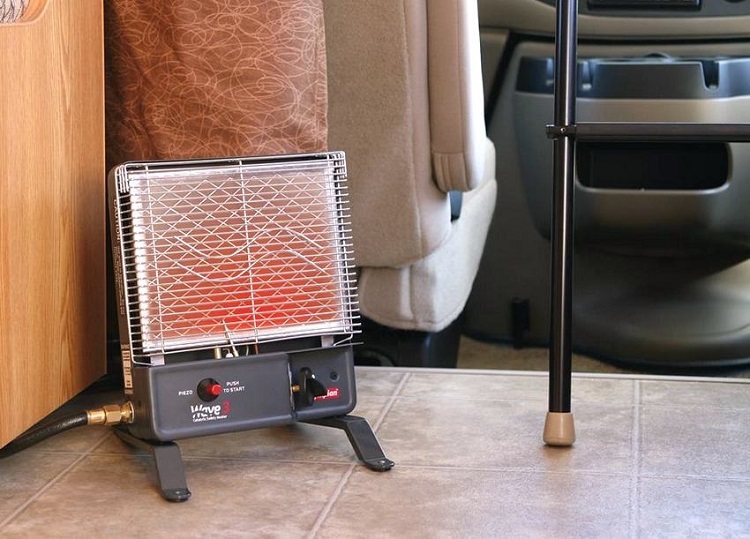
Installations operating due to infrared radiation are used in residential buildings and in open areas. In the process of obtaining heat energy, low-spectrum waves are used, which are absolutely safe for health.
Devices with an infrared emitter heat the surrounding objects without spending extra energy on heating the air. However, it is not recommended to heat small rooms with them, especially those less than 10 m². Due to their high performance, they can be used outdoors for efficient heating of summer verandas and other open spaces.
We wrote about the types of infrared emitters and the rules for choosing the best option in this article.
Conventional catalytic heaters heat the air, not the surrounding objects. Among them there are miniature portable devices and rather large installations, resembling a large boiler in appearance.
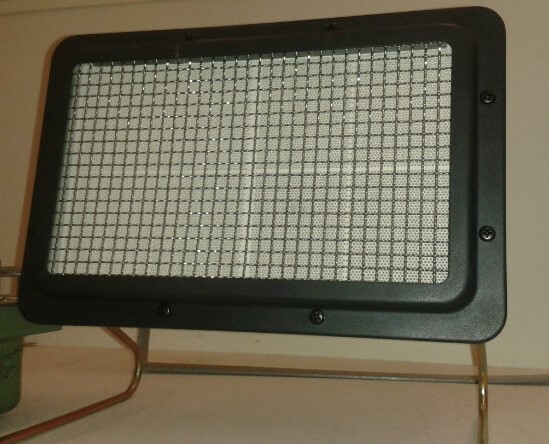
Manufacturers produce units in a variety of designs. There are models in the form of a reflector, fireplace, floor column on wheels. Some equipment is additionally equipped with a hob for outdoor cooking
The average performance of gas heaters is about 2900 W. The power of models, additionally equipped with a fan and heating element, reaches 4900 W. The heating area depends on the power of the device.
Differences from gasoline and multi-fuel models
Gas appliances are the most common, but not the only type of catalytic equipment. Heating units can be operated with other types of fuel.
Depending on this criterion, three more types of devices are distinguished:
- Gasoline. Apparatuses with a built-in fuel tank connected to a catalytic cartridge. Gasoline vapors in them enter the cartridge and undergo oxidation when interacting with the catalyst. Mobility and modest size contribute to the special popularity of gasoline heaters among outdoor enthusiasts, hunters, fishermen.
- On industrial alcohol. Constructions with a special inner compartment, which holds a container with alcohol or dry fuel. Presented by small-sized models weighing no more than 1.5-2 kg. They are used exclusively in the field: they heat tents, dry clothes, warm up food and drink.
- Multi-fuel. Universal heaters that work with any available fuel, both gaseous and liquid. They are characterized by a rather limited power - 500-1200 watts.
In addition to external characteristics, there are no significant differences between gas, gasoline and multi-fuel catalytic heaters. They all work on the principle of catalytic combustion and have a similar internal structure.
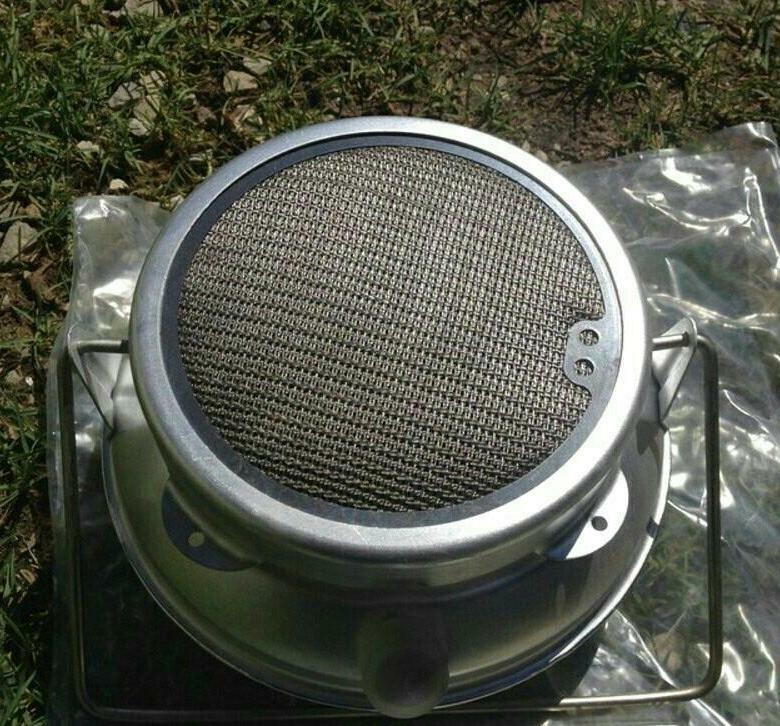
The main advantages of gasoline and multi-fuel models are mobility, compact dimensions, and a relatively affordable price. As for the technical and operational parameters, gas installations surpass them by an order of magnitude.
Gas appliances are easier to maintain, have high performance, and are designed for a wide range of applications.
Gasoline devices are a little more difficult to operate. To ensure efficient and trouble-free operation, they must be refueled with the highest purity gasoline.
Pros and cons of catalytic appliances
As with any type of equipment, catalytic heaters have a number of advantages and disadvantages that must be considered when choosing.
The devices have many positive aspects:
- compactness and low weight - dimensions and convenient design of most models make it easy to move and install devices, portable options fit easily into the trunk of a car or a small hiking bag;
- environmental friendliness - due to the fact that the heaters do not emit harmful combustion products and unpleasant odors, a healthy microclimate remains in the room, the risk of carbon monoxide poisoning is completely absent;
- security - the absence of a flame during operation eliminates the likelihood of a fire, the device can be safely used in a house, in a tent, in a warehouse, in an industrial workshop;
- profitability - working at full capacity, the devices consume 100-300 g of fuel per hour, in many models the performance can be adjusted;
- fuel availability - the cylinder can be easily purchased or fill with gas at any gas station;
- simplicity of the device - the design is devoid of complex mechanisms, everything is arranged as simply and clearly as possible.
But there are also negative nuances. The most significant disadvantage is limited service life. Although marketers claim that the plate is capable of working up to 8 years, in practice, according to a number of statements users, the time does not exceed 2500 hours, which is associated with the gradual burnout of the catalyst in the process heating.
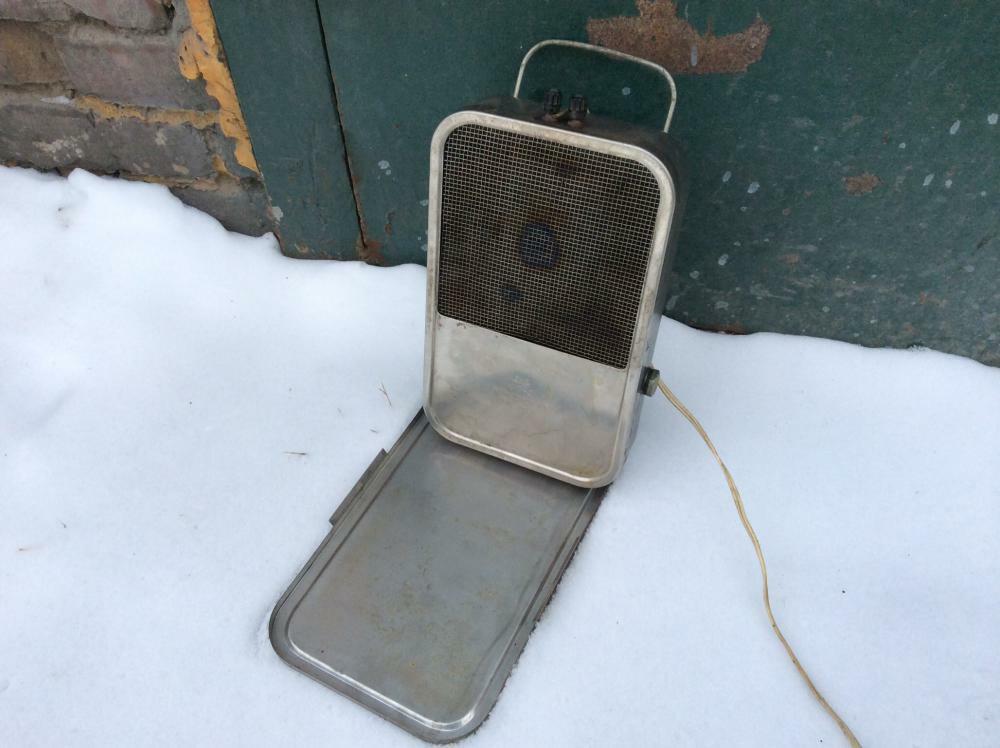
If the device is used around the clock, the catalyst resource will be exhausted after about 5 months of operation. The expediency of replacing a failed plate is questionable: it will cost 2/3 of the price of a new device.
The second drawback is serious dependence on the quality of the fuel mixture. Poorly refined fuel affects heating efficiency and shortens equipment life, quickly rendering it unusable.
Many consumers attribute to disadvantages high cost catalytic gas appliances. On average, a heater of this type with a capacity of 2900 W costs about 11,000 rubles.
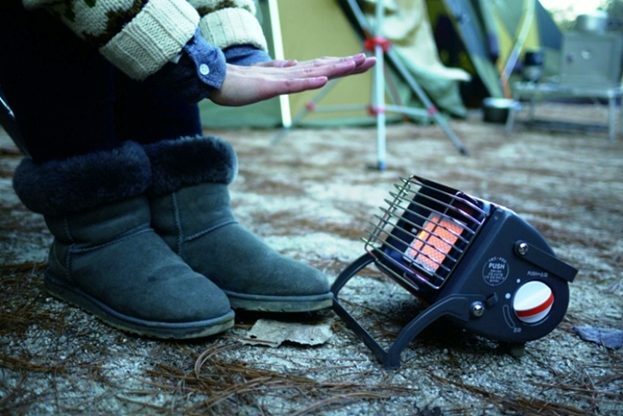
It is undesirable to place catalytic equipment in bedrooms, rooms with high humidity, next to flammable objects. Do not dry wet shoes and clothes on it.
Despite the safety of catalytic equipment, during use it is necessary to adhere to the operating rules recommended by the manufacturer.
We also recommend watching tips for safe operation bottled gas in the apartment.
Choosing the optimal heater
When choosing a suitable heater, it is necessary to take into account many nuances, evaluate the convenience of design, functionality, additional features and equipment of the model you like. Consider the main criteria for making the right choice.
Criterion # 1 - place and conditions of application
The first step is to decide on the purposes for which you plan to buy a catalytic device. The optimal type of design and the set of characteristics required in this case depend on where and in what conditions the apparatus will be used.
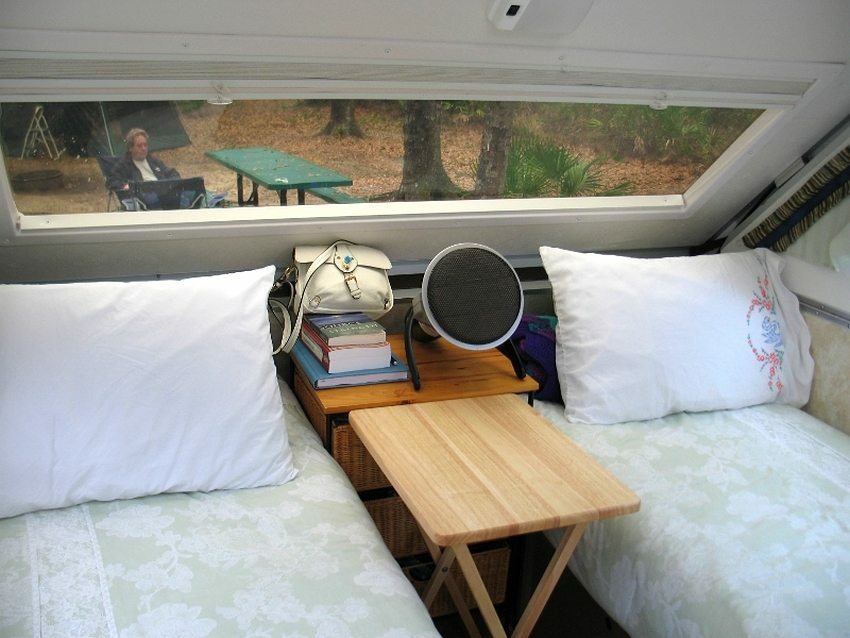
For work in nature, small portable devices are designed that can easily fit in a backpack and do not depend on the availability of communications
The main indicators should be selected taking into account the conditions of the upcoming operation, the parameters of the heated object. It is necessary to take into account the expected frequency of application, heating area, preview reviews of real buyers about the model.
So, for space heating, it is worth buying larger heaters with sufficient power and automatic safety sensors. If the device will need to be repositioned frequently, it is better to choose a mobile design on wheels.
Criterion # 2 - technical characteristics
One of the main parameters of a heater is power. To choose a device with the correct performance, you should perform preliminary calculations, consult with the seller, and carefully study the instructions. The technical documentation should indicate the area for which the power of a particular model is calculated.
In addition, you need to pay attention to the following characteristics:
- gas consumption - how much fuel is required for operation, whether the device is economical;
- dimensions - what is the width, length and height of the device, is there enough space in the room to provide free space around it (1.5 m in front, 0.2 m in the back and sides);
- control type - mechanical or electronic;
- weight and volume of the provided container - whether the apparatus is too heavy, how difficult it will be to move and install.
It is important to check the package contents and its compatibility with the equipment. The standard set includes reducer, gas hose, sometimes a cylinder. If any of the elements does not fit with the device, it is necessary to purchase suitable adapters.
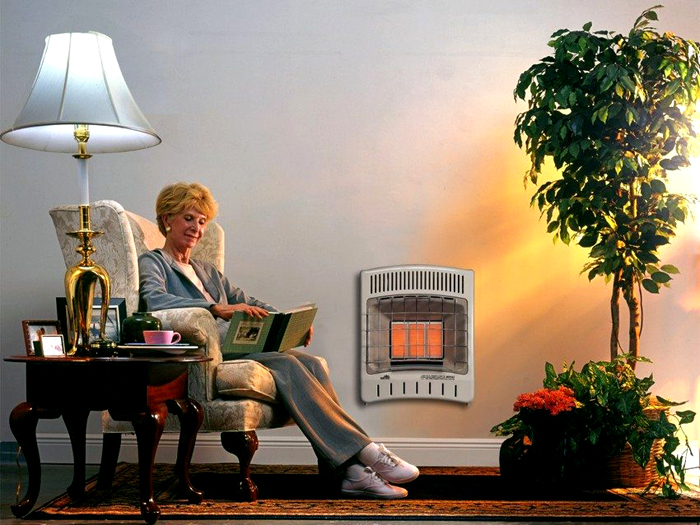
The range of catalytic heaters includes models with different performance ranges. Devices with a capacity of up to 2.9 kW are capable of heating an area of 30-35 m². A power of about 4 kW is suitable for rooms up to 60 m². There are also low-power devices that heat no more than 12 m². Their performance is about 1.2 kW
It is desirable that the heater be equipped with additional design and functionality.
The main add-ons and features are as follows:
- automatic power control in several modes;
- a horizontal position sensor that turns off the device in case of a sharp mechanical impact, skew, overturning;
- indoor carbon dioxide level control system;
- infrared heating;
- piezo ignition;
- electric turbofan;
- overpressure relief valve.
For greater ease of use, it is worth choosing a device with wheels for free movement, handles, dummy legs installed in different positions.
Review of the best manufacturers
An extensive range of catalytic heaters is represented by various imported and domestic brands. Consider several manufacturers whose products are recognized by consumers as the best in this area.
No. 1 - reliable and functional Bartolini devices
Heating equipment of the Italian brand Bartolini is the most in demand on the market. The company produces rather powerful devices with a performance from 2900 to 4200 W, working on liquefied gas.
The main emphasis in production is placed on the independence of the equipment from the availability of communications.

Almost all the models presented are equipped with gas cylinders built into the body, have several power modes with the possibility of step adjustment, offered in different versions complete set. The operation of the devices is based on the conversion of thermal energy into infrared radiation
Heaters from the Italian manufacturer can be purchased at a price of 11 to 18 thousand rubles. They are distinguished by good quality, reliability, economical fuel consumption.
Most of them have CO2 monitoring sensors, rollover shutdown systems. The model is especially in demand among buyers. Bartolini pulloverk.
# 2 - compact and economical models from Campingaz
The next most popular company is Campingaz. This French company produces efficient and safe gas heaters for residential, warehouse, retail and industrial premises. Special attention is paid to portable equipment that provides a comfortable stay in nature.
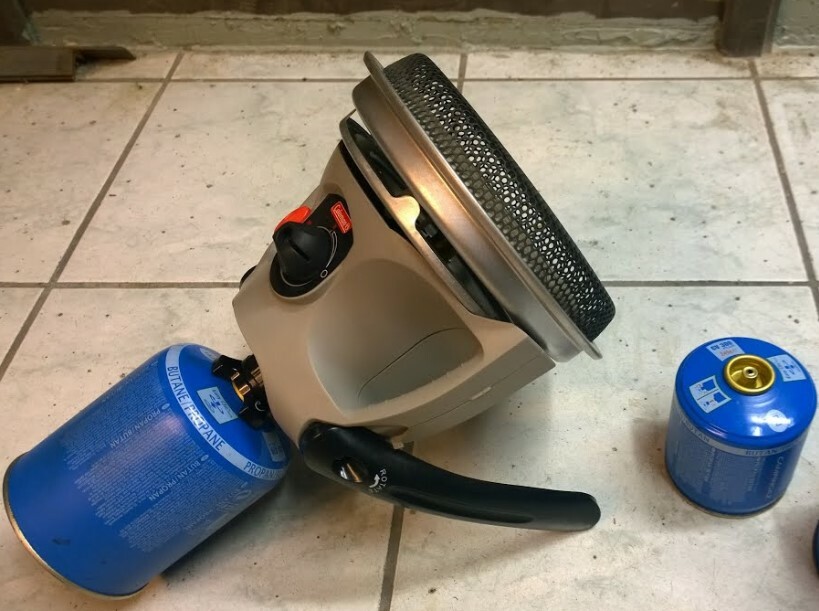
Campingaz heaters are characterized by small dimensions, stylish modern design, and a long working life. They are equipped with reliable sensors-analyzers, which guarantee the safe operation of the device.
The brand's devices provide excellent heat transfer and have European quality certificates. New technologies of economical fuel consumption are involved in their production.
The average cost of products is 11 thousand rubles. The best representative of the range is considered Campingaz cr 5000 turbo.
No. 3 - comfortable and safe heaters from the Kovea brand
The Korean company Kovea offers customers gas heaters of various designs. Mostly these are compact portable models of low power, operating on the basis of infrared radiation.
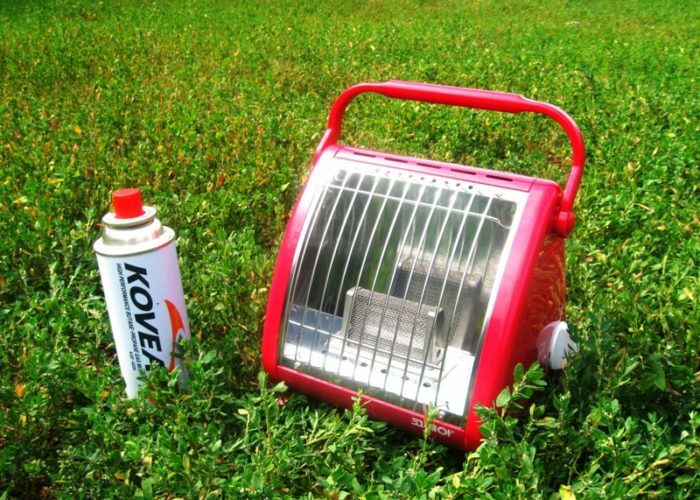
The main difference between Kovea heaters is the simplicity of the device, compactness and light weight. They are very convenient to use, but they are designed for heating a small area. They are mainly used outdoors, on hikes, in small garages and utility rooms.
The Korean manufacturer practically does not use plastic elements in the design of its devices, which further increases the safety of operation. The average price of products is 5-8 thousand rubles.
No. 4 - inexpensive and durable heaters from Argo
The budget version of the catalytic heater is offered by the domestic manufacturer Argo. The gas heat generator of this company is designed for heating industrial premises, garages, verandas with normal air circulation. Farmers often use it in greenhouses, sheds.
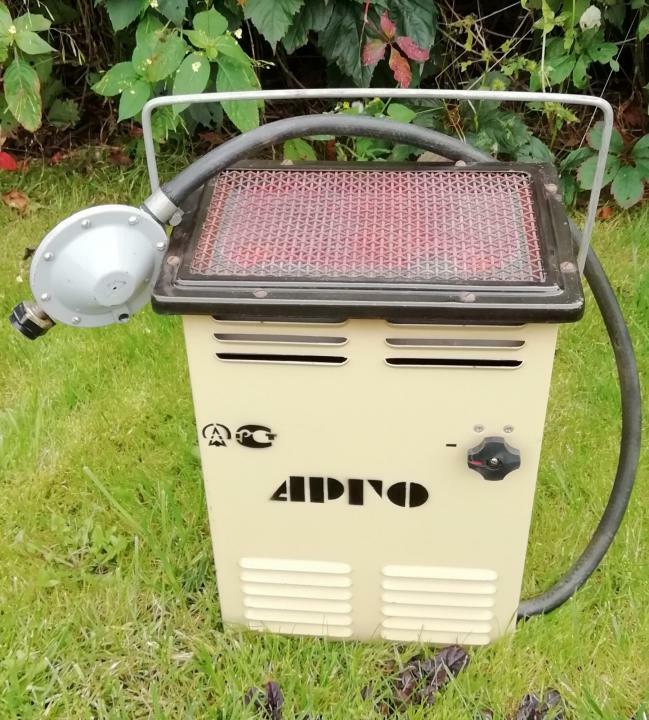
The device operates on gas supplied through a special hose from a cylinder with a volume of 5-15 liters. With a performance of 2900 W, 250 g / h of fuel is consumed. Despite the minimum percentage of carbon dioxide emission, it is impossible to operate the device in poorly ventilated rooms.
With not too large dimensions, the weight of the device is 6.7 kg. There are no wheels in it, so it is rather difficult to move it over long distances. But for stationary use, it is quite suitable. The approximate cost of the device is 2000 rubles.
Does the catalytic version of the device seem unreasonably expensive to you as a temporary heater for a summer residence? We recommend that you familiarize yourself with other gas appliancessuitable for heating temporary premises.
Conclusions and useful video on the topic
Recommendations for the selection of devices, the main design differences of the models:
The feasibility, pros and cons of using a catalytic heater in the following video:
The process of applying the catalyst to the surface of the plate at home:
How catalytic combustion occurs is a visual experiment in the following video:
Gas heat generators of catalytic type are an excellent option for temporary heating of various premises, heating garages, tents, greenhouses. They are completely safe: during their operation, no harmful combustion products and unpleasant odors are emitted..
A large selection of sizes and designs makes it easy to choose the device, both for stationary use, and one that you can easily take with you on the road. When choosing a catalytic heater, you need to focus on the operational characteristics of the room, individual requirements, and financial capabilities. It is also important to give preference to reliable manufacturers with a positive reputation in the market.
Do you use a gas fired heater with a catalytic plate and want to share your opinion on the advisability of purchasing such a device with other users? Tell us about the pros and cons identified during operation, add unique photos of your heater model in the comments block below.


